
- 200 pages
- English
- ePUB (mobile friendly)
- Available on iOS & Android
eBook - ePub
Concise Townscape
About this book
This book pioneered the concept of townscape. 'Townscape' is the art of giving visual coherence and organization to the jumble of buildings, streets and space that make up the urban environment. It has been a major influence on architects, planners and others concerned with what cities should look like.
Frequently asked questions
Yes, you can cancel anytime from the Subscription tab in your account settings on the Perlego website. Your subscription will stay active until the end of your current billing period. Learn how to cancel your subscription.
No, books cannot be downloaded as external files, such as PDFs, for use outside of Perlego. However, you can download books within the Perlego app for offline reading on mobile or tablet. Learn more here.
Perlego offers two plans: Essential and Complete
- Essential is ideal for learners and professionals who enjoy exploring a wide range of subjects. Access the Essential Library with 800,000+ trusted titles and best-sellers across business, personal growth, and the humanities. Includes unlimited reading time and Standard Read Aloud voice.
- Complete: Perfect for advanced learners and researchers needing full, unrestricted access. Unlock 1.4M+ books across hundreds of subjects, including academic and specialized titles. The Complete Plan also includes advanced features like Premium Read Aloud and Research Assistant.
We are an online textbook subscription service, where you can get access to an entire online library for less than the price of a single book per month. With over 1 million books across 1000+ topics, we’ve got you covered! Learn more here.
Look out for the read-aloud symbol on your next book to see if you can listen to it. The read-aloud tool reads text aloud for you, highlighting the text as it is being read. You can pause it, speed it up and slow it down. Learn more here.
Yes! You can use the Perlego app on both iOS or Android devices to read anytime, anywhere — even offline. Perfect for commutes or when you’re on the go.
Please note we cannot support devices running on iOS 13 and Android 7 or earlier. Learn more about using the app.
Please note we cannot support devices running on iOS 13 and Android 7 or earlier. Learn more about using the app.
Yes, you can access Concise Townscape by Gordon Cullen in PDF and/or ePUB format, as well as other popular books in Architecture & Architecture General. We have over one million books available in our catalogue for you to explore.
Information

the private square: enclosed
GENERAL STUDIES:
Squares for All Tastes
Town squares, once the preserve of privilege, have since the wartime salvage of railings become public spaces. (This is taken from a study written in 1947.) It is unlikely and undesirable that they should all return to their old use, but so far no definite proposals have been put forward for bringing them into line with the needs of a changed society. These pages demonstrate, with examples chosen from London, how Britain's squares could be made to serve life as it is lived in our towns today. The particular squares named are token ones merely used for the purposes of illustration. The aim is to put forward principles which may be applied anywhere. Right at the start let it be pointed out that where function and architectural unity still march together no change is advocated.
Thus where the square is still residential it could well remain a private or communal garden, enclosed and screened from passers-by by the usual railings.

the private square: open
A variation on the private enclosed square is the private open square, which is guarded only by hazards such as those of judicious planting and Engchanges of level. In quiet neighbourhoods such squares do not need further protection, and this immunity encourages a freer excursion into urban landscaping in the technical meaning of informal non-academic layout.
With justification we may assume the precinctual organization of cities and a more equal distribution of privileges. Put together in terms of town planning, the result will be the square as quadrangle protected from all but local traffic.
While the metropolitan square is an amenity which should not remain barred to all but the few who happen to overlook it, that does not imply the obliteration of all distinctions. As Mayfair happens to be expensive and exclusive, then this should deter mine the character of Grosvenor Square in its renascent public form. The presence of the American Embassy, together with the square's wartime associations as moral G.H.Q. of American troops in England, has prompted the authorities to make of it a memorial to President Roosevelt, a scheme which has had wide public support. Why not make Grosvenor Square a real American Corner? Not the America associated in the eyes of Europeans with vulgarization; the connection is with Fifth Avenue rather than Broadway. The best American food, exclusive underground cinema, swans and fountains (but not a soda fountain). On great occasions the American Embassy could hold garden parties in the square. A corner of London that is America for both Londoners and Americans.
the public square
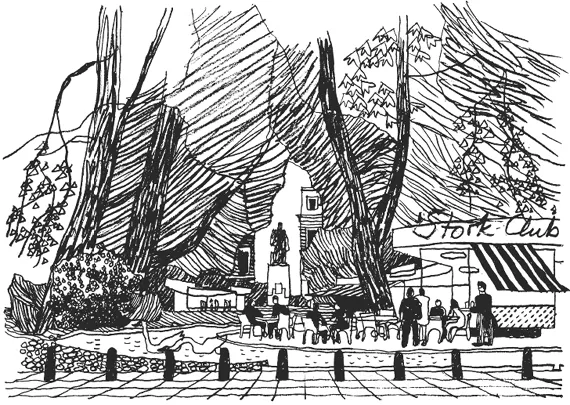
the popular square
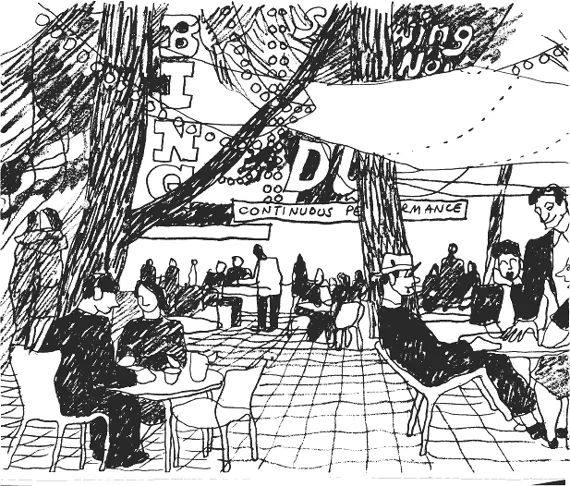
A view of Leicester Square in the eighteenth century would be virtually impossible to reconcile with its present condition, a boisterous jungle of traffic, changing signs, vivid lettering and garish posters. The desperate pre-war attempt to preserve a be-railed garden, although a pleasing evidence of official grit and determination, was always a flop. It simply induced a depressing feeling of prohibition, the feeling that one was being inhibited for the wrong reason. Far better to obtain the feeling of space and openness by sweeping away the railings and laying down a paved floor throughout. There are sufficient cafes round the square to rent space for tables, as is done in France, and gaily coloured velariums suspended between the trees would give protection from birds and rain. What is most important, however, is for the landscapist to under stand the vital and popular visual appeal of the Leicester Square type of landscape. The fact that it is the aesthetic expression of the dive and pin-table saloon, is no reason for the urban planner to turn up his nose. These activities, for better or for worse, are a part of urban life, and as such make a very valuable contribution to the visual scene.

the square as quadrangle: municipal square
In a complete squares policy there should be a place for everything—even the undiluted monumental. The existing buildings and proposals for the future of Russell Square suggest that its character should be municipal and monumental. The buildings which surround it are on the whole massive and monumental, London University, the Imperial and Russell Hotels and the new office blocks. Where there is a marked change in the use and character of the boundaries of the square it is reasonable to suggest a general change of character to utilize the drama which traffic in volume can produce. That is to say, the monumentality should flow right through with all its devices of the axis, fountains, seats and sculpture, and so produce an unsubtle yet impressive effect of metropolitanism.
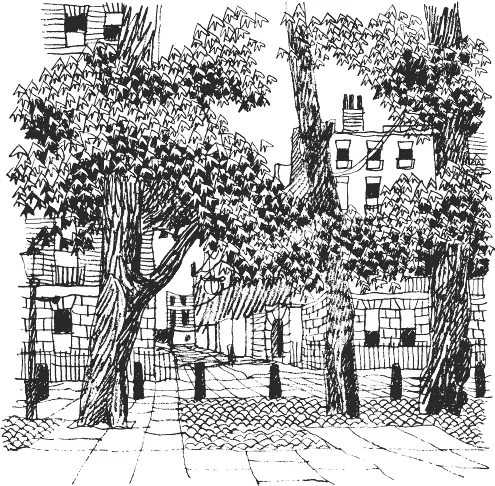
the square as quadrangle: the collegiate square
With the reorganization of traffic and the formation of precincts the flow of vehicles will be reduced to those which have business in the area. Even so in certain squares there should be pedestrian priority— that is to say, if there is a pedestrian and a taxi, the taxi gets out of the way of the pedestrian. The attempt to preserve a few square feet of cat-ridden, sooty turf in the smaller public squares is surely hardly worth the trouble. Rather pave the whole area as in the Temple Courts, which will emphasize the collegiate atmosphere and the pedestrian priority; it will also emphasize the fact that these squares have become the property of all. The quadrangle is the basis or neutral pattern which will vary as local conditions change. It may be municipal as in the example of Russell Square, exclusive as in Grosvenor Square, popular as in Leicester Square, or quietly collegiate as in this example of Manchester Square.
Cross as Focal Point
The idea of the town as a place of assembly, of social intercourse, of meeting, was taken for granted throughout the whole of human civilization up to the twentieth century. You might assemble in the Forum at Pompeii or round the market cross, but you still assembled; it was a ritual proper to man, both a rite and a right. Nor in the general way did you have to explain whether your motives were proper or profane. Men are gregarious and expect to meet. In all ages but ours, that is. Here the Poultry Cross at Salisbury 2, and over page, is taken as an example of the sort of process that endangers places of congregation in our age.
Observation suggests that a fixed object acts as a magnet to movable objects: in 1, at Minehead, Somerset, the trees have attracted to themselves a weighing machine and a nameplate device. It is obvious that the motive for this arrangement arises from the desire to be tidy and not clutter up free space with separate objects over which people could stumble.
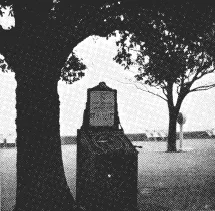
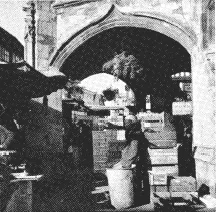
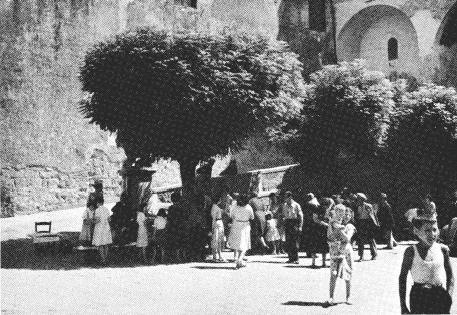

However, the most movable object in town is the human being and, for possibly different reasons, he too needs anchorage. He needs it in the various out-door activities of trade, recreation and social life. Now, to provide open space so that these activities can take place at all, is in itself not really sufficient. Open space as an element in the town is essential but it needs also to be furnished with such objects as will turn the disassociated stream of people into groups as in 3, previous page, at Orvieta, Italy. For people are gregarious and need the incident, the feature or the anchor. In the case of a ...
Table of contents
- Front Cover
- Half Title
- Title Page
- Copyright
- CONTENTS
- Acknowledgements
- Introduction
- Introduction to 1971 Edition
- Casebook
- General Studies
- Endpiece
- Index